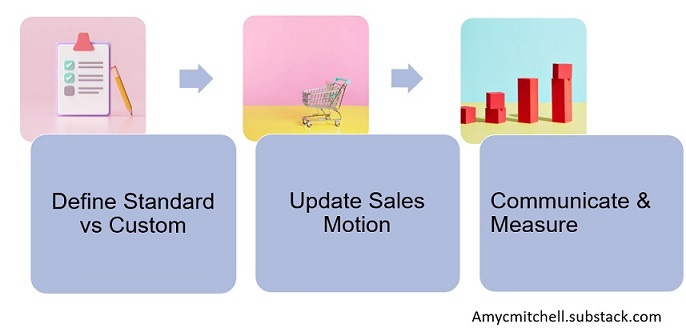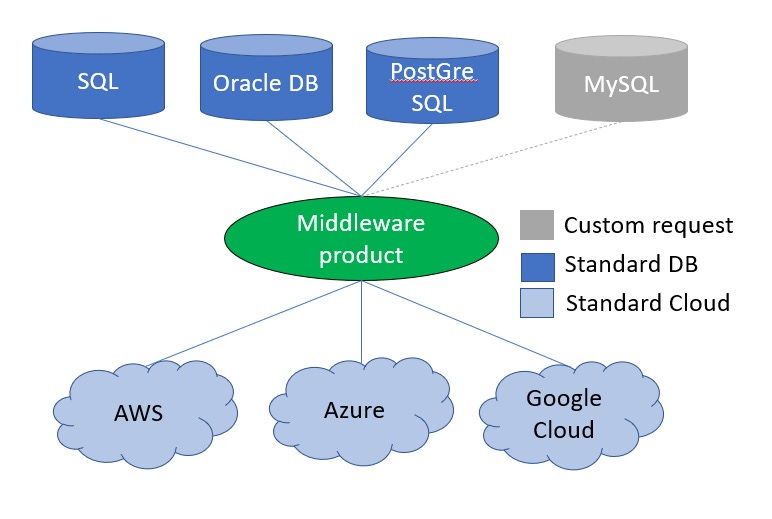Balancing Customization with Business Objectives
3 Steps to creating custom solutions for multiple customers
Your product is finally selling after building it into an integrated solution. Your first customers needed some special changes in the solution to fit their requirements. Demand is rising for your solution with customizations but no one sees value in the customizations. In many cases, the customizations have material costs and are given away to customers for free.
How do you put value on the customizations to the solution without alienating your sales team or reducing the margin? Product and solution customizations are tricky and don't scale well. Customers do like a custom solution that fits their exact needs. You can thread this needle by taking these steps:
Define your standard solution and what is allowed for custom requests
Establish a quote-to-cash process for customization requests on your standard solution
Communicate about the business case forecast and actuals
Let's discuss how you get ahead of the customizations and how the whole solution team profits from these changes.
Step 1: Define What is Standard and What is Custom
It is important for the whole team to understand the standard offer and what is allowed to be customized. Each component product in the solution likely has a datasheet and other documentation. As a solution leader, you need to define the standard ways to put together the components and the choices for customization.
For example, you are a product manager for a database middleware product that supports multiple 3rd party databases and runs on the major public clouds. So far you have developed solutions for 3 databases running in 3 different clouds. The solution looks like this:
You got to this point by selling custom projects to your initial customers. Each of these sales was slow due to contract work and unplanned engineering work. You need a controlled way to accelerate support for more databases. Your next step is to define your standard solution and your custom handling like this:
Next, you define your custom request package:
Guidelines for a custom request
Pricing guide for the customization
Contract template for the customization
In the above example your custom request package would be:
A form to request customization:
Customer name and opportunity size
Timing for the customization
Reason the customer needs the customization
Customer's alternative if the customization is not delivered
Description of the customization with any specifics that engineering would need to estimate the effort
Compatibility guide
The 3rd party databases and versions that are supported
The Public Cloud instances that are supported
Shipping and end-of-support Middleware product versions
Guideline for requesting a customization
What customization is/is not - when it is better to make a roadmap request
The process to request customization and what to expect
Timing expectations
Who to contact for questions
Pricing guide for your business team
How to gather the costs for a request
Guideline for marking up the cost to meet the business case forecast
List of approvers to review the cost and price before customer presentation
A proposal template to present the pricing to the sales team
Customization contract template - pre-approved by your legal team
Description of the customization
Set up fees and recurring fees
Special terms and conditions such as licensing, cancellation terms, and handling of changes
As the solution leader, you are in the best position to draft these documents working with engineering and legal. It's okay to use the draft documents until the process is established. Early on it is important to use the process to have controlled requests coming to engineering.
At this point, your engineering team is happy with the change in handling customizations. You update your business case and your stakeholders on the impacts of this change. You know the next step is the hardest part of monetizing customization requests!
Step 2: Put Customization Requests into Your Sales Motion
It is challenging to insert customization requests in the quote-to-cash process because this is the heart of your business. Some sensitivities to be aware of:
Impacts on sales compensation: customization fees might be outside the standard sales compensation model
Sales velocity impacts: delays in estimating and pricing customization projects can delay an off-the-shelf sale
Manual financial actions: monthly recurring efforts can eat up the margin on customization projects
Business stakeholders: there could be hidden stakeholders that need to be involved in customization requests
You don't want these issues to hold you back in launching the customization request process. Here is what you do in the above example to head off objections:
Make sure the customization fees are covered in a similar manner to your middleware product:
Decide if the customization is a product or a service for sales compensation handling
Follow the standard for a product vs. service for revenue and cost handling
Understand the margin expectations based on product vs. service
Reach out to key sales leaders on:
The benefits of the new customization requests
Review the sales forecast with the new customization fees
How to use the new compatibility guide
How to request customization early in the sales cycle
The importance of separating a customization request from standard revenue - otherwise revenue will be deferred until the customization is delivered
Get feedback on the new contract template
Contact your business stakeholders with your finance leaders to:
Review the benefits of the customization process
Show the business case with the customization requests modeled in it
Quantify the likely incremental effort and how it is lowered with the new process
Agree on the next steps to launch customization requests
With these steps behind you, you make final adjustments to the customization requests and begin trying the process out. The first few requests are rough and you remain strong on the vision for customization requests.
Step 3: Communicate Many Times
Introducing customization requests is a big change that affects multiple teams. Expect to talk to stakeholders, internal teams, external vendors, and customers for a while as they become familiar with the changes. Be prepared to calmly address objections and misunderstandings.
To make it easy to request customization, put the customization package on an internal web page. Key items for this page are:
Customization request form
Compatibility guide
Customization request guide
Contract template
Don't worry about how it looks - have these key items in one place. It can be a folder, a SharePoint, or a very basic webpage. Over time you might need to add a FAQ to address typical questions and issues.
Besides presenting the vision of customization requests many times, you will want to set up a way to keep internal teams updated on progress. A few ways to keep your team informed about progress are:
An internal dashboard of in-progress customization requests showing:
Description of the request by the customer
Status of the request - draft request, final request, estimating, approved, developing, etc.
Opportunity driving the request
Periodic update to stakeholders and the product team on the progress:
The number of requests approved, delivered, etc.
P&L of the customization requests
Actuals vs forecast in the business case
Lessons learned and process improvements
Centralizing the information on the value and the efficiencies in the customization process helps stakeholders and the affected teams adapt to managing the customization requests.
Conclusion
When you find yourself in a situation of multiple requests for solution support, putting controls on the requests can save time and prevent cost overruns. By establishing a customization request method, you can pull together engineering and business stakeholders into your solution in an efficient way.
The steps to take in balancing customization with business objectives are:
Step 1: Make it clear what is included in your standard solution and what can be customized
Step 2: Set up a process for dealing with customization requests rapidly
Step 3: Keep everyone in the loop about how customizations are affecting the business
Using these strategies you can balance the customization requests against your standard solution.





Love the suggestions on digging in from a solution perspective. I tend to lean heavier business in my day-to-day but I think it's a good reminder of the benefits getting a little deeper in the tech.